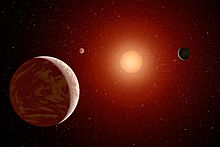| Observation data Epoch J2000 Equinox J2000 | |
|---|---|
| Constellation | Ophiuchus |
| Right ascension | 16h 30m 18.05839s [1] |
| Declination | −12° 39′ 45.3212″ [1] |
| Apparent magnitude (V) | 10.07 [2] (10.05 - 10.10) [3] |
| Characteristics | |
| Spectral type | M3.5V [4] |
| U−B color index | +1.20 [5] |
| B−V color index | +1.57 [2] |
| Variable type | BY Draconis [3] |
| Astrometry | |
| Radial velocity (Rv) | −21.80±0.13 [1] km/s |
| Proper motion (μ) | RA: −94.210 mas/yr [1] Dec.: −1,183.917 mas/yr [1] |
| Parallax (π) | 232.1390±0.0268 mas [1] |
| Distance | 14.050 ± 0.002 ly (4.3078 ± 0.0005 pc) |
| Absolute magnitude (MV) | 11.87 [4] |
| Details | |
| Mass | 0.304±0.007 [6] M☉ |
| Radius | 0.319±0.007 [6] R☉ |
| Luminosity (bolometric) | 0.0110±0.0001 [6] L☉ |
| Luminosity (visual, LV) | 0.0015 L☉ |
| Temperature | 3,307+38 −36 [6] K |
| Metallicity [Fe/H] | −0.09±0.09 [4] dex |
| Rotation | 95 d [4] |
| Other designations | |
| BD−12°4523, G 153-058, GCTP 3746.00, GJ 628, HIP 80824, LHS 419, Vys 164 | |
| Database references | |
| SIMBAD | data |
| Exoplanet Archive | data |
Wolf 1061 (also known as HIP 80824 and V2306 Ophiuchi) is an M-class red dwarf star located about 14.1 light-years away in the constellation Ophiuchus. It is the 36th-closest-known star system to the Sun and has a relatively high proper motion of 1.2 seconds of arc per year. Wolf 1061 does not have any unusual spectroscopic features. [7]





